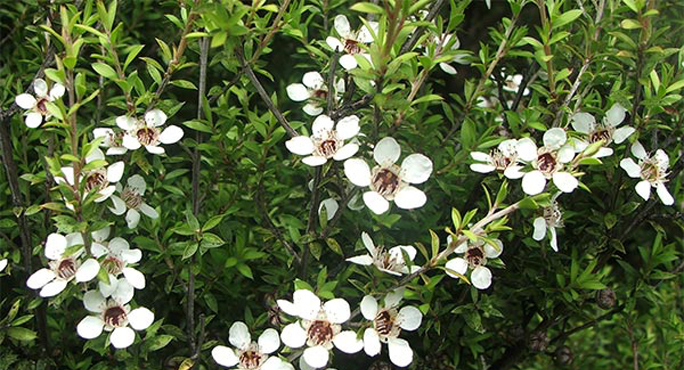
Manuka Flowering in New Zealand
Our body’s largest organ is our skin, stretching from the tips of our toes to the top of our head. Our skin is exposed to the outer world, and is subject to cuts, nicks, abrasions, burns, bites, stings, punctures, eruptions, sores, and a host of insults.
Over the course of traveling to tropical jungles, bug-infested locations, harsh windy plains, mountains and other challenging environments, I have learned a lot about first aid for skin. On one memorable trip to the Brazilian Amazon, I wound up treating the skin problems of a small neighborhood of Ipixuna indians.
Over the course of a month, I was able to successfully treat open wounds, cuts, bites, stings, infections and even flesh-eating fungus. In the 17 intervening years I have paid very close attention to what really works to heal skin. And when I travel, various natural skin remedies are always in my bag. These remedies enjoy not only a history of effective traditional use, but good science as well.
Here, to add to your medicine chest, are my three most widely natural first aid remedies for skin.
1. Burns, Wounds, Acne
From the far-flung Pacific regions of Oceania, Tamanu Oil is my most widely employed skin healing agent, for all the right reasons. First of all, tamanu oil relieves the pain of a burn, bite or sting, and does so quickly. I have even used tamanu oil successfully to treat a scorpion sting on my foot.
Tamanu oil has antioxidant properties, so it helps to protect skin cells. It is potently anti-inflammatory, so it is very useful on sensitive or irritated skin. Tamanu oil has significant cicatrizing properties, which means that it causes the formation of new healthy skin tissue. It’s pretty much the single best thing for burns of any kind. Additionally, tamanu oil kills pimples fast and radically speeds up their healing. A little bit of nutty-smelling tamanu oil goes a long way. Women in Polynesia apply tamanu oil to reduce stretch marks after giving birth.
In a harsh or windy environment applying a thin layer of tamanu oil to skin will prevent drying and chapping. Applied to toenail fungus, tamanu gets rid of the problem, however advanced. I have seen tamanu used successfully for the treatment of long-time plantar warts (Veruca plantaris). It is indispensible for treating bites, stings, cuts, abrasions, and any kind of bad thing that can happen to skin.
Try: New Chapter’s Tamanu Oil
2. Infections
Thousands of bacteria exist in our environment, and many of them wind up on our skin. If we experience a scrape, cut, puncture or other penetrating insult, bacteria can infect skin tissue and lead to spreading infections, fever, and systemic sickness. Distilled from the leaves of Leptospermum scoparium, and native to New Zealand, manuka oil is a superior first aid remedy for topical uses.
It possesses very powerful antibacterial and anti-fungal activity. Manuka oil is used clinically to treat burns, is a traditional remedy of the native Maori, and its history includes use by Captain Cook. The primary compounds of note in manuka oil are Leptospermome, iso-Leptospermome and Flavesone. In tests performed with various types of bacteria that can infect skin, manuka oil showed very high anti-bacterial and anti-fungal activity. Soothing and possessing somewhat of a pine aroma, manuka can be applied to any open wounds, and will help to reduce or eliminate the spread of infection. Applied to pimples it will kill the bacteria inside. Used on bites and stings, manuka helps to reduce pain and inflammation. I always use manuka oil when treating an open wound.
My recommendation: The manuka oil from East Cape Manuka
3. Anti-Microbial and Anti-Tumor Activity
I also travel with a bottle of propolis extract. Propolis is a potent anti-microbial resinous substance varying from brown to dark green, made by bees to line their hives. Bees collect the basic resinous materials for propolis from several parts of plants, and manufacture this protective material using their own enzymes. Propolis is used by the bees to narrow the entrance of beehives to reduce penetration by cold, wind, fungus and bacteria.
Propolis lines hives to maintain a sterile environment, thus protecting the entire hive. If a small animal gets into a hive, the bees sting it to dath and then cover it with propolis to mummify it and prevent hive contamination. Propolis is also used as a construction material inside the beehive.
When propolis hardens, it is extremely sturdy material. Propolis is yet one more tremendous skin-protector. I like the liquid propolis preparations, which not only kill bacteria and fungus, but can be used to inhibt tumor growth (still see your doctor). I have used propolis extract to successfully treat MRSA (methycillin-resistant staphylococcus auria), to kill pimples rapidly, and to seal wounds. The resinous nature of propolis creates a thin barrier on wounds, not only providing anti-infective power, but also sealing the wound from further invasion.
Try: I like the fluid propolis from Uniflora

